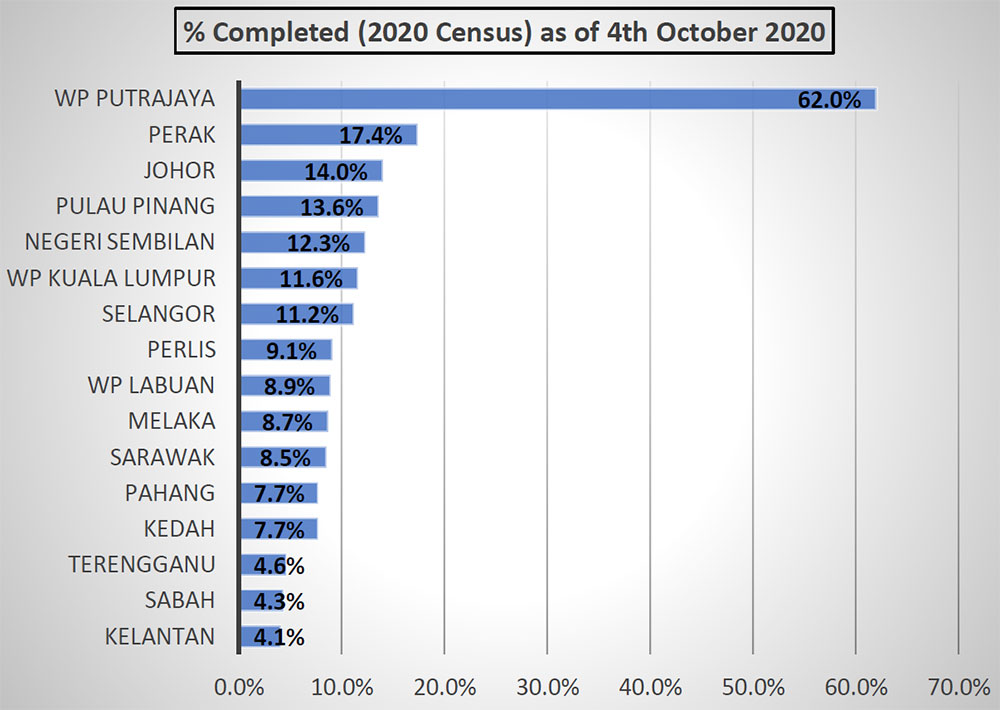MP SPEAKS | The national census, which takes place once every 10 years, is an important data collecting exercise for the country. The census data will be used by government agencies at the federal, state and local levels for planning purposes and allocation of resources.
The private sector will also use the census for various purposes, including planning for future housing development and retail areas. As such, it is important to ensure that the results of the 2020 Census are as accurate as possible. Unfortunately, the Covid-19 virus has the potential to disrupt the collection of information for the 2020 Census.
The announcement by the Minister in the Prime Minister’s Department, Mustapa Mohamed, and Malaysia’s Chief Statistician Mohd Uzir Mahidin, on Oct 5, 2020, that the face-to-face portion of the 2020 Census will be postponed to 2021 is a much-welcomed move.
The announcement that the e-census deadline will be extended from Sept 30, 2020, to Dec 21, 2020, is also a good move. This is in view of the growing number of locally transmitted Covid-19 cases in the country. But the Department of Statistics Malaysia (DOSM), which is in charge of the 2020 Census, needs to do more to prepare for the face-to-face census taking which will take place from Jan 20 to Feb 6, 2021.
As of Oct 4, 2020, only 3.25 million of the population, or approximately 10 percent, had been recorded using the 2020 E-Census. This relatively low response rate could be caused by a number of factors, including:
(i) Respondents have not received the ‘postcard’ from DOSM with the ‘invitation code’ to fill in the e-census;
(ii) Respondents do not know how to access the E-Census website; and
(iii) Respondents do not know how to fill up the E-Census.
I filled up the census for my household of two persons and it took me more than half an hour to fill in the response to more than 100 questions. Those who have not yet filled up the E-Census are likely to be from groups which are less IT savvy, from the older generation or living in the rural areas. While it is a positive move to encourage more people to fill up the census electronically, the reality is that the majority of the census will have to be filled using face-to-face interviews.
According to figures from the census website, many of the states with large rural populations have recorded a relatively low response rate to the E-Census, including Kelantan (4.1 percent), Sabah (4.3 percent), Terengganu (4.6 percent), Kedah (7.7 percent), Pahang (7.7 percent) and Sarawak (8.5 percent).

At the same time, Selangor, the state with the largest population in Malaysia (6.3 million or approximately 20 percent of the country’s population), which is also an urbanised state, only had a response rate of 11.2 percent as of Oct 4.
Even with the extension of the deadline for the E-Census to Dec 21, 2020, it is likely that as much as 80 percent of the eight million households in Malaysia will have to fill up the 2020 Census using the face-to-face method. DOSM has set the dates of Jan 20 to Feb 6, 2021, for the completion of the face-to-face portion of the 2020 Census. With a window of 17 days and perhaps as many as 6.4 million households to survey across the country, it is estimated that DOSM will require at least 38,000 census takers/enumerators. For Sarawak alone, it is estimated that 8,000 census takers are needed.
These census takers need to be trained on how to help the respondents fill up the census document, including in languages other than Bahasa Malaysia, if necessary, and they have to be mobilised to their designated areas.
The original timeline for the face-to-face portion of the census was supposed to have taken place from the Oct 7 to 24, 2020. In the lead-up to this original start date, my office started receiving many messages from the Hulu Langat District Office and other sources regarding a recruitment drive for census takers. I am not sure if the quota for these census takers was filled up, but I foresee a similar challenge for DOSM to recruit and fill up these temporary positions in 2021.
I call upon DOSM to work with the various agencies at the state and federal levels, including those who are searching for jobs to fill up these temporary positions. The recruitment drive should start earlier, in order to avoid last-minute requests to fill these positions.
Finally, DOSM should also consider increasing the length of time for the face-to-face census from 17 days to 24 days or even longer, since the census filling process may take a longer time because of Covid-19 related safety precautions and SOPs.
ONG KIAN MING is Bangi MP and assistant political education director of the DAP. - Mkini
The views expressed here are those of the author/contributor and do not necessarily represent the views of MMKtT.



No comments:
Post a Comment
Note: Only a member of this blog may post a comment.